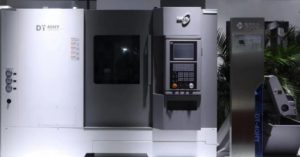Different orientations in programming
Horizontal machining center:
This type of machining center has 3 to 5 motion coordinates, typically three linear motion coordinates and one rotary motion coordinate. With just one clamping, the workpiece can be processed on all surfaces except for the mounting and top surfaces.
Vertical machining center:
In contrast, the vertical machining center has three linear motion coordinate axes. It can also have a rotary table on the workbench that rotates along the horizontal axis, allowing for the processing of spiral parts.
Different methods of programming
Horizontal machining centers:
These centers feature an automatic tray exchange device called an Automatic Pallet Changer (APC), which can switch worktables in just 45 seconds. This efficient process helps save time on auxiliary tasks.
Vertical machining centers:
In the vertical machining centers, manual loading, unloading, and tool magazine replacement can be carried out during the machine’s automatic cycle.
Different methods of programming and monitoring
Horizontal machining center:
Accurate oil supply is crucial in this type of center. By adding a regulating valve, the oil can be effectively delivered to lubrication points such as the main shaft and lead screw, based on their specific requirements.
Vertical machining center:
These centers are equipped with automatic detection and monitoring systems. They can detect abnormal lubrication conditions and trigger alarms, prompting the machine to stop and prevent any potential equipment malfunction.
It should be noted that each axis is different. The main shaft in a horizontal machining center is typically positioned on the Y-axis, while in a vertical machining center, it is on the Z-axis. Operators must be careful during feeding and withdrawing to avoid any collisions or accidents.









